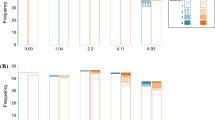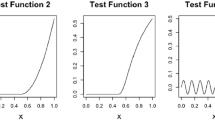Abstract
Mixed discrete and continuous outcomes are commonly measured on each experimental unit in dose-response studies in toxicology. The dose-response relationships for these outcomes often have dose thresholds and nonlinear patterns. In addition, the endpoints are typically correlated, and a statistical analysis that incorporates the association may result in improved precision. We propose an extension of the generalized estimating equation (GEE) methodology to simultaneously analyze binary, count, and continuous outcomes with nonlinear threshold models that incorporates the intra-subject correlation. The methodology uses a quasi-likelihood framework and a working correlation matrix, and is appropriate when the marginal expectation of each outcome is of primary interest and the correlation between endpoints is a nuisance parameter. Because the derivatives of threshold models are not continuous at each point of the parameter space, we describe the necessary modifications that result in asymptotically normal and consistent estimators. Using dose-response data from a neurotoxicity experiment, the methodology is illustrated by analyzing five outcomes of mixed type with nonlinear threshold models. In this example, the incorporation of the intra-subject correlation resulted in decreased standard errors for the threshold parameters.
Similar content being viewed by others
References
Boos, D. D. (1992), “On Generalized Score Tests,” The American Statistician, 46, 327–333.
Bull, S. B. (1998), “Regression Models for Multiple Outcomes in Large Epidemiologic Studies,” Statistics in Medicine, 17, 2179–2197.
Casey, M., Gennings, C., Carter, W. H. Jr., Moser, V. C., and Simmons, J. E. (2004), “Detecting Interaction(s) and Assessing the Impact of Component Subsets in a Chemical Mixture Using Fixed-Ratio Mixture Ray Designs,” Journal of Agricultural, Biological, and Environmental Statistics, 9, 399–361.
Contreras, M., and Ryan, L. M. (2000), “Fitting Nonlinear and Constrained Generalized Estimating Equations with Optimization Software,” Biometrics, 56, 1268–1271.
Cox, C. (1987), “Threshold Dose-Response Models in Toxicology,” Biometrics, 43, 511–523.
Crowder, M. (2001), “On Repeated Measures Analysis with Misspecified Covariance Structure,” Journal of the Royal Statistical Society, Series B, 63, 55–62.
Dunson, D. B. (2000), “Bayesian Latent Variable Models for Clustered Mixed Outcomes,” Journal of the Royal Statistical Society, Series B, 62, 355–366.
— (2003), “Dynamic Latent Trait Models for Multidimensional Longitudinal Data,” Journal of the American Statistical Association, 98, 555–563.
Dunson, D. B., Chen, Z., and Harry, J. (2003), “A Bayesian Approach for Joint Modeling of Cluster Size and Subunit-Specific Outcomes,” Biometrics, 59, 521–530.
Dunson, D. B., and Herring, A. H. (2005), “Bayesian Latent Variable Models for Mixed Discrete Outcomes,” Biostatistics, 6, 11–25.
Fitzmaurice, G. M., and Laird, N. M. (1997), “Regression Models for Mixed Discrete and Continuous Responses with Potentially Missing Values,” Biometrics, 53, 110–122.
Gordon, C. J., Herr, D. W., Gennings, C., Graff, J., McMurray, M., Stork, L., Coffey, T., Hamm, A., and Mack, C. (2006), “Thermoregulatory Response to an Organophosphate and Carbamate Insecticide Mixture: Testing the Assumption of Dose-Additivity,” Toxicology, 217, 1–13.
Gray, S. M., and Brookmeyer, R. (2000), “Multidimensional Longitudinal Data: Estimating A Treatment Effect From Continuous, Discrete, or Time-to-Event Response Variables,” Journal of the American Statistical Association, 95, 396–406.
Han, K. E., Catalano, P. J., Senchaudhuri, P., and Mehta, C. (2004), “Exact Analysis of Dose Response for Multiple Correlated Binary Outcomes,” Biometrics, 60, 216–224.
Huber, P. J. (1967), “The Behavior of Maximum Likelihood Estimates under Nonstandard Conditions,” in Proceedings of the Fifth Berkeley Symposium on Mathematics, Statistics, and Probability, 1, Berkeley, CA: University of California Press, pp. 221–233.
Kosorok, M. R., Shi, Y., and DeMets, D. L. (2004), “Design and Analysis of Group Sequential Trials with Multiple Primary Endpoints,” Biometrics, 60, 134–145.
Lefkopoulou, M., Moore, D., and Ryan, L. (1989), “The Analysis of Multiple Correlated Binary Outcomes: Application to Rodent Teratology Experiments,” Journal of the American Statistical Association, 84, 810–815.
Liang, K. Y., and Zeger, S. L. (1986), “Longitudinal Data Analysis using Generalized Linear Models,” Biometrika, 73, 13–22.
Liang, K. Y., Zeger, S. L., and Qaqish, B. (1992), “Multivariate Regression Analyses for Categorical Data” (with discussion), Journal of the Royal Statistical Society, Series B, 54, 3–40.
Lipsitz, S. R., Laird, N. M., and Harrington, D. P. (1991), “Generalized Estimating Equations for Correlated Binary Data: Using the Odds Ratio as a Measure of Association,” Biometrika, 78, 153–160.
Littell, R. C., Milliken, G. A., Stroup, W. W., and Wolfinger, R. D. (1996), SAS System for Mixed Models, Cary, NC: SAS Institute Inc.
Liu, C., and Rubin, D. B. (1998), “Ellipsoidally Symmetric Extensions of the General Location Model for Mixed Categorical and Continuous Data,” Biometrika, 85, 673–688.
McCullagh, P. (1983), “Quasi-likelihood Functions,” The Annals of Statistics, 11, 59–67.
McCullagh, P., and Nelder, J. A. (1989), Generalized Linear Models (2nd ed.), London: Chapman and Hall.
Miglioretti, D. L. (2003), “Latent Transition Regression for Mixed Outcomes,” Biometrics, 59, 710–720.
Moran, P. A. P. (1971), “Maximum Likelihood Estimators in Non-Standard Conditions,” Proceedings of the Cambridge Philosophical Society, 70, 441–450.
Moser, V. C., Casey, M., Hamm, A., Carter, Jr. W. H., Simmons, J. E., and Gennings, C. (2005), “Neurotoxicological and Statistical Analyses of a Mixture of Five Organophosphorus Pesticides Using a Ray Design,” Toxicological Sciences, 86, 101–115.
Muthen, B., and Shedden, K. (1999), “Finite Mixture Modeling with Mixture Outcomes Using the EM Algorthm,” Biometrics, 55, 463–469.
Prentice, R. L., and Zhao, L. P. (1991), “Estimating Equations for Parameters in Means and Covariances of Multivariate Discrete and Continuous Responses,” Biometrics, 47, 825–839.
Rochon, J. (1996), “Analyzing Bivariate Repeated Measures for Discrete and Continuous Outcomes,” Biometrics, 52, 740–750.
Rochon, J., and Gillespie, B. W. (2001), “A Methodology for Analysing a Repeated Measures and Survival Outcome Simultaneously,” Statistics in Medicine, 20, 1173–1184.
Rotnitzky, A., and Jewell, N. P. (1990), “Hypothesis Testing of Regression Parameters in Semiparametric Generalized Linear Models for Cluster Correlated Data,” Biometrika, 77, 485–497.
Sammel, M. D., Ryan, L. M., and Legler, J. M. (1997), “Latent Variable Models for Mixed Discrete and Continuous Outcomes,” Journal of the Royal Statistical Society, Series B, 59, 667–678.
Schwartz, P. F., Gennings, C., and Chinchilli, V. M. (1995), “Threshold Models for Combination Data From Reproductive and Developmental Experiments,” Journal of the American Statistical Association, 90, 862–870.
Shults, J., Mazurick, C. A., and Landis, J. R. (2006), “Analysis of Repeated Bouts of Measurements in the Framework of Generalized Estimating Equations,” Statistics in Medicine, 25, 4114–4128.
Silvapulle, M. J. (1991), “On Testing for Threshold Values,” Biometrics, 47, 1628–1629.
Stram, D. O., and Lee, J. W. (1994), “Variance Components Testing in the Longitudinal Mixed Effects Model,” Biometrics, 50, 1171–1177.
Ulm, K. (1991), “A Statistical Method for Assessing a Threshold in Epidemiological Studies,” Statistics in Medicine, 10, 341–349.
Wedderburn, R. W. M. (1974), “Quasi-likelihood Functions, Generalized Linear Models, and the Gauss-Newton Method,” Biometrika, 61, 439–447.
Zeger, S. L., and Liang, K. Y. (1986), “Longitudinal Data Analysis for Discrete and Continuous Outcomes,” Biometrics, 42, 121–130.
— (1991), “Feedback Models for Discrete and Continuous Time Series,” Statistica Sinica, 1, 51–64.
Zhao, P. L., and Prentice, R. L. (1990), “Correlated Binary Regression Using a Quadratic Exponential Model,” Biometrika, 77, 642–648.
Author information
Authors and Affiliations
Rights and permissions
About this article
Cite this article
Coffey, T., Gennings, C. The simultaneous analysis of mixed discrete and continuous outcomes using nonlinear threshold models. JABES 12, 55–77 (2007). https://doi.org/10.1198/108571107X177690
Received:
Revised:
Issue Date:
DOI: https://doi.org/10.1198/108571107X177690




